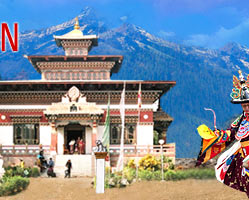Situated in the south central Bhutan, Royal Manas National Park lies to the north of Manas National Park in Assam, which is a World Heritage Site; and to the south of Jigme Singye Wangchuck National Park. Royal Manas was declared a wildlife sanctuary in 1966 and thus, has the status of being the oldest protected area in Bhutan. Later, it was upgraded to the status of being a National Park and it became the first national park of Bhutan. Royal Manas National Park is one of the world’s few sites that offer us stupendous variety of life forms and ecosystems. Royal Manas wildlife sanctuary harbors thousands of animals and plant species including several globally endangered species.
Sprawled across 1,023 km2, Royal Manas National Park with its adjoining India's Manas Tiger Reserve and Jigme Singye Wangchuck National Park constitute one of the largest landscape level protected areas in the eastern Himalayas. The Parks are full of tropical and sub tropical ecosystems and have evergreen tropical forests, sub-tropical forests and warm and cool broadleaf forests. There are about 45 species of mammals including gaur, extremely rare golden langur, Asian elephant, hispid hare, clouded leopard, Royal Bengal tiger, gangetic dolphin, pangolin, Himalayan black bear, clouded leopard, sloth bear and wild water buffalo in Royal Manas National Park.
About 366 species of birds have been recorded here including rare aerial fauna such as chestnut-breasted partridge; great white-bellied heron, Palas fish eagle, blue-headed rock thrush, rufous-necked hornbill and white-naped yuhina, spotted wren-babbler and emerald cuckoo. It is believed that about 200 species of other birds also make Royal Manas their home. Residents of Royal National Park are mostly farmers and in the past, tseri or slash-and-burn cultivation had been practiced in here. Crops that grow here include maize, paddy, buckwheat, millet, and foxtail millet while the cash crops include mustard, orange and cardamom. Bamboo and canes are also found here in abundance.
Climatic variations in Royal Manas sanctuary are quite notable. There is about 5000 mm of rain during monsoon season that lasts from May to September while rainfall in winter is quite negligible and weather remains very pleasant from November till February. More than 900 types of plants are there in Royal Manas and many of them have commercial, medicinal, traditional and religious significance. WWF and Bhutan’s Nature Conservation Division are jointly running programs such as providing training and equipments to the park staff, improving park infrastructure and supporting biological and socio-economic surveys and park monitoring programmes.




